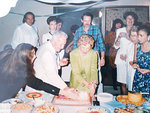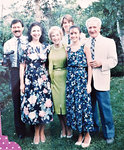




Editor’s note: In last week’s story, we looked at Chatham County’s Jessica Bryan and her experiences as a caregiver for her mother, Pauline, who suffered from Alzheimer’s disease for 25 years — and what today’s (and tomorrow’s) caregivers can learn from Bryan. The story concludes this week with a look at Pauline’s furtehr decline and the stark realities of caring for an aging parent, and tips for those facing those circumstances.
Pauline Pulizzi had a bad fall.
On that day in 2009, the 90-year-old got into the chairlift in her daughter and son-in-law’s north Chatham home, as she did when she was headed upstairs, but she forgot how to do it properly. When she got to the top of the stairs, her toe snagged in the base plate. Daughter Jessica Bryan, who was on a work call in her home office, heard one thump, then a series of thumps in quick succession. She raced into the room to find her mother at the foot of the stairs in a pool of blood, bone protruding from her broken wrist.
Bryan screamed, thinking she’d lost her mom. Then Pulizzi moaned, and Bryan realized she was still alive, though badly hurt. Pulizzi ended up in the hospital with a broken wrist and clavicle. Once Pulizzi was out of the hospital and through with rehab, Bryan had the conversation with her again.
You aren’t being forced and this is your choice, Bryan said, but would you consider assisted living?
This time, Pulizzi was more receptive.
“When I found the right place for her, she went,” says Bryan. “She told me every day for a year and a half probably how happy she was.”
Pulizzi, Bryan’s mother, lived almost a century, dying a month shy of her 100th birthday last May 6. For 25 of those years, she lived with Alzheimer’s, with Bryan tracing the first signs of her mother’s dementia to a mid-90s game night in suburban Los Angeles. As described in greater detail in the first story of this two-part series, Bryan’s mother and father moved with her from California to north Chatham, where they lived in an apartment at her house. Upon Bryan’s father’s death, Pulizzi’s Alzheimer’s symptoms became far more conspicuous, culminating in her fall. Like countless caregivers in countless towns, Bryan knew it was time for an assisted living facility. Staying home was simply too risky.
Yet the future held unwelcome surprises.
“When you’re managing somebody’s finances, which we had to do, we had it figured very carefully,” said Bryan during a recent interview at the Pittsboro office of Real Living Carolina Lifestyles Realty, where she is managing broker. “We figured that she could live to be 107.6 years old — until that recession hit.”
Rent at an assisted living facility, Bryan explains, can run about $7,000 a month, or from $8,000 to $12,000 monthly if a person needs more assistance. Pulizzi had stocks and was living off the dividends, which was the source of Bryan’s calculations. When the recession of 2008 and 2009 hit, Bryan had to cash in Pulizzi’s stocks and then dig into Pulizzi’s savings just to pay the assisted living rent and cost of care. On top of that, the assisted living facility in which Pulizzi was living was sold four times, and each time the rent got pricier. Even a family with resources found itself struggling to keep up. A year in assisted living, Bryan says, can run $100,000 out-of-pocket.
“And how many people are living a really long time, needing assistance?” Bryan asks. “My mom had Alzheimer’s 25 years. She needed assistance for 20 of those years. Do the math.”
A household making Chatham County’s median income pulls down $59,684 annually, per U.S. Census Bureau data. While the median household income in Chatham County is higher than the rest of the state on average, as the Chatham County Aging Plan 2018-2023 notes, there remains stark income inequality. The northeastern corner of the county is wealthier as a rule, while pockets in the west and southwest see average household incomes tens of thousands of dollars lower. In portions of Siler City, for instance, the median income is less than $30,000 annually.
By the time Pulizzi came home again, Bryan was paying her assisted living facility rent out of her own pockets, but was also upset to see her mom increasingly ostracized. People with dementia no longer have the same filters, she notes, and they can be quite rude to each other. As Pulizzi’s decorum and hygiene slid, her social circle at the assisted living facility deteriorated as well. She would blow her nose, for example, and then touch all the food at a buffet. And she wasn’t bathing as often or as well, either.
“It [was] just time, so we went and got her,” says Bryan. “She was officially out of money. We were covering all of her costs at that point anyway.”
While Pulizzi required more attention than she had before her stay in assisted living, Bryan didn’t mind it initially — it was OK until it wasn’t OK, as she puts it. It turned decidedly not OK in Pulizzi’s final year, when she became violent and paranoid. Both Bryan and her husband had to all but stop working because Pulizzi required constant attention.
“The number one stress most of the time with someone with dementia [is] you’re the 24/7 caregiver,” says Susan Hardy, community care manager with the Chatham Council on Aging. “You don’t get a break.”
Oftentimes, the caregiver can’t let the person with dementia out of their sight, out of constant (and often justified) worrying about what their loved one is going to do next. Yet Hardy’s advice sounds like the caregiver equivalent of putting on your own oxygen mask first: you can’t help another person unless you take care of yourself.
“We want you to thrive, not just survive,” she says. “We want you to stay healthy the whole time you’re care-giving.”
Hardy’s advice includes simple things such as meditation or an attainable action plan related to something the caregiver actually wants to do for themselves. Don’t put unnecessary pressure on yourself to walk 45 minutes if you want only make time for 10, Hardy offers as an example; and don’t make an action plan to clean out a closet unless it’s what you actually want to do.
Chatham County lacks an adult activity center, Hardy says, which could ease caregiver stress. These are places where a caregiver can leave their loved one so they can run an errand on their own, say. Many prefer this to home health, she says, because there’s no additional pressure to clean up the home beforehand. What the Council envisions, Hardy says, is similar to Lee County’s Family Promise Program, which serves homeless families, or Wake County’s Win Project. The idea is to work with the faith community and identify churches that can host seniors for day activities on a rotating basis, with people in those communities trained in the methods of dementia care expert Teepa Snow.
“We’re looking at it like a day activity program, one day a week, once a quarter per church. We’d have activities set up in the church with volunteers trained to be there,” says Hardy. During these four-hour blocks, caregivers could simply get a break.
Bryan dealt with the pressure by writing. At the time that Pulizzi came home, Bryan had written some two-dozen books, so blogging and writing books about her caregiver experiences was a natural enough way to turn lemons to lemonade.
“I spit anger and vitriol and all of this onto the pages, and at the end I’d go ‘You know what? I really love my mother,’” Bryan says. “I would cry it out. I’d finish a chapter and I’d sit there and I’d cry, and I’d go, ‘Wow, that was kind of cathartic. I feel much better.’”
Caregivers who read her work felt the same way, she says. You gave me permission to feel angry, they said. You explained what I’m going through, they said. I feel heard, they said.
Yet life at home became unsustainable. It was difficult for Realtor Bryan and her home designer husband to recover financially from the recession and also be Pulizzi’s full-time caretakers. “I kept saying to my husband, ‘I don’t want this to be my last memories of my mother, because these are ugly times,’” Bryan says.
By the end of her time at home, Pulizzi resisted the slightest thing violently — getting out of a chair, for instance — and she was strong, says Bryan. Finally, Pulizzi went to live in a nursing home for her last two months.
“Mom died and immediately I felt that I had gone through this process for a reason,” Bryan says. “I had so much clarity in that.”
When Bryan remembers her mother, sure, she can remember the woman who, at 99, took off all her clothes outside while workers were building a house immediately next door, but she can also remember the elegant, intelligent woman who valued etiquette and the arts; She can remember the woman who could keep others laughing for hours. With clarity and retrospect, today Bryan can see a path forward — one that’s educated by her own years as her mother’s caretaker.
“I’ve got to bring people to the realization that we are in a crisis and we have to face it now,” Bryan says with conviction. “Hey, it hasn’t worked for climate change,” she adds with a dark chuckle.
And then Bryan composes herself quickly, and the conviction returns. Even though there she has a strong family history of Alzheimer’s, she has largely graduated from fear. Worrying is futile and time is fleeting, so her plan now is to create good memories and to make a difference — even if it’s a small one, she says. From dementia research to the importance of planning ahead to understanding what Alzheimer’s does to a person, Bryan has a clear picture of the challenges that need to be addressed.
“That’s where I see myself going,” she says.